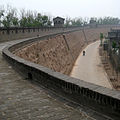Pingyao
Coordinates: 37 ° 12 ' N , 112 ° 9' E
Pingyao ( Chinese 平遙 / 平遥 , Pinyin Píngyáo ) is a medium- sized town in Shanxi Province in China with about 42,000 inhabitants, around 80 kilometers southwest of the provincial capital Taiyuan . Pingyao is the capital of the district of the same name . In Europe, the city is primarily known for its Ming period cityscape, which was also included in the list of world cultural heritage by UNESCO in 1997 .
geography
Pingyao is located on the eastern edge of the northern Chinese loess plateau, at the transition from the Taiyuan basin to the floodplain of the Hui Ji and Liu Gen rivers. The climate is continental, with long cold winters and mild to warm summers. The Fen River, one of the tributaries of the Huang He flows west of the city . The main part of the population is made up of Han Chinese , other population groups are Hui Chinese , Manchu and Mongols .
history

First evidence of human settlement in the region goes back to the Paleolithic . The history of the city itself can be traced back to the time of the western Zhou dynasty at the turn of the 9th to the 8th century BC. The erection of an earth wall as the first city fortification probably also fell during this time. During the spring and autumn annals , Pingyao was part of the Jin realm. The city was first mentioned under the name Zhongdu at this time.
After several name changes during the Qin and Han periods, the city was given its final name Pingyao in AD 424 under the rule of the northern Wei , which it has kept to this day. Since China was divided into 36 districts under the rule of the first emperor Qin Shi Huang Di in 221 BC, Pingyao has also been the district capital of the district of the same name. During the Period of the Five Dynasties and Ten Kingdoms , Pingyao was conquered, looted, and burned down in 960 during a war between the Northern Song and Northern Han Dynasties.
In 1370, under the rule of the Ming Emperor Hongwu , the city was expanded considerably and the now larger city fortifications were built as a wall with an earth core. Since then, Pingyao has developed into a financial center of China through the entire period of the Ming and Qing Dynasties and dominated the Chinese financial sector in the second half of the 19th century. Due to the rise of the Chinese coastal cities in the course of the economic influence of the western colonial powers, however, Pingyao lost its importance to Hong Kong and Shanghai at the end of the 19th and beginning of the 20th century and has not recovered from this loss of importance until today. Due to the resulting lack of financial strength and significance, Pingyao was largely spared the destruction caused by modernization and the cultural revolution and was thus able to preserve its historically grown old town. Pingyao today has the longest completely preserved Ming Age city wall in China, which has been on the list of monuments of the People's Republic of China since 1988 , and still has a large number of historical courtyard houses. In 1997 Pingyao was included in the UNESCO World Heritage Site .
Pingyao County
With the division of China into administrative districts under the rule of the first Emperor Qin Shi Huang Di , Pingyao County was established and the city of Pingyao was declared its capital. The district extends over an area of 1260 km 2 and today has around 490,000 inhabitants.
Pingyao pictures
literature
- The Story of Pingyao . Shanxi Science and Technology Press, ISBN 7-5377-2395-8
- Report of the UNESCO Assessment Committee ( PDF )
Web links
- UNESCO information page on Pingyao
- Entry on the UNESCO World Heritage Center website ( English and French ).
Individual evidence
- ↑ UNESCO World Heritage Center: Ancient City of Ping Yao. Retrieved August 13, 2017 .









